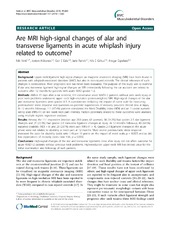| dc.contributor.author | Vetti, Nils | en_US |
| dc.contributor.author | Kråkenes, Jostein | en_US |
| dc.contributor.author | Eide, Geir Egil | en_US |
| dc.contributor.author | Rørvik, Jarle | en_US |
| dc.contributor.author | Gilhus, Nils Erik | en_US |
| dc.contributor.author | Espeland, Ansgar | en_US |
| dc.date.accessioned | 2010-12-13T09:04:11Z | |
| dc.date.available | 2010-12-13T09:04:11Z | |
| dc.date.issued | 2010-11-11 | eng |
| dc.Published | BMC Musculoskeletal Disorders 11:260 | en |
| dc.identifier.issn | 1471-2474 | |
| dc.identifier.uri | https://hdl.handle.net/1956/4334 | |
| dc.description.abstract | Background: Upper neck ligament high-signal changes on magnetic resonance imaging (MRI) have been found in patients with whiplash-associated disorders (WAD) but also in non-injured controls. The clinical relevance of such changes is controversial. Their prognostic role has never been evaluated. The purpose of this study was to examine if alar and transverse ligament high-signal changes on MRI immediately following the car accident are related to outcome after 12 months for patients with acute WAD grades 1-2. Methods: Within 13 days after a car accident, 114 consecutive acute WAD1-2 patients without prior neck injury or prior neck problems underwent upper neck high-resolution proton-weighted MRI. High-signal changes of the alar and transverse ligaments were graded 0-3. A questionnaire including the impact of event scale for measuring posttraumatic stress response and questions on patients’ expectations of recovery provided clinical data at injury. At 12 months follow-up, 111 (97.4%) patients completed the Neck Disability Index (NDI) and an 11-point numeric rating scale (NRS-11) on last week neck pain intensity. Factors potentially related to these outcomes were assessed using multiple logistic regression analyses. Results: Among the 111 responders (median age 29.8 years; 63 women), 38 (34.2%) had grades 2-3 alar ligament changes and 25 (22.5%) had grades 2-3 transverse ligament changes at injury. At 12 months follow-up, 49 (44.1%) reported disability (NDI > 8) and 23 (20.7%) neck pain (NRS-11 > 4). Grades 2-3 ligament changes in the acute phase were not related to disability or neck pain at 12 months. More severe posttraumatic stress response increased the odds for disability (odds ratio 1.46 per 10 points on the impact of event scale, p = 0.007) and so did low expectations of recovery (odds ratio 4.66, p = 0.005). Conclusions: High-signal changes of the alar and transverse ligaments close after injury did not affect outcome for acute WAD1-2 patients without previous neck problems. High-resolution upper neck MRI has limited value for the initial examination and follow-up of such patients. | en_US |
| dc.language.iso | eng | eng |
| dc.publisher | BioMed Central | eng |
| dc.rights | Attribution CC BY | eng |
| dc.rights.uri | http://creativecommons.org/licenses/by/2.0 | eng |
| dc.title | Are MRI high-signal changes of alar and transverse ligaments in acute whiplash injury related to outcome? | en_US |
| dc.type | Peer reviewed | |
| dc.type | Journal article | |
| dc.rights.holder | Vetti et al. | |
| dc.rights.holder | Copyright 2010 Vetti et al; licensee BioMed Central Ltd. This is an Open Access article distributed under the terms of the Creative Commons Attribution License (http://creativecommons.org/licenses/by/2.0), which permits unrestricted use, distribution, and reproduction in any medium, provided the original work is properly cited. | |
| dc.identifier.doi | https://doi.org/10.1186/1471-2474-11-260 | |
| dc.subject.nsi | VDP::Medisinske Fag: 700::Klinisk medisinske fag: 750::Radiologi og bildediagnostikk: 763 | nob |

